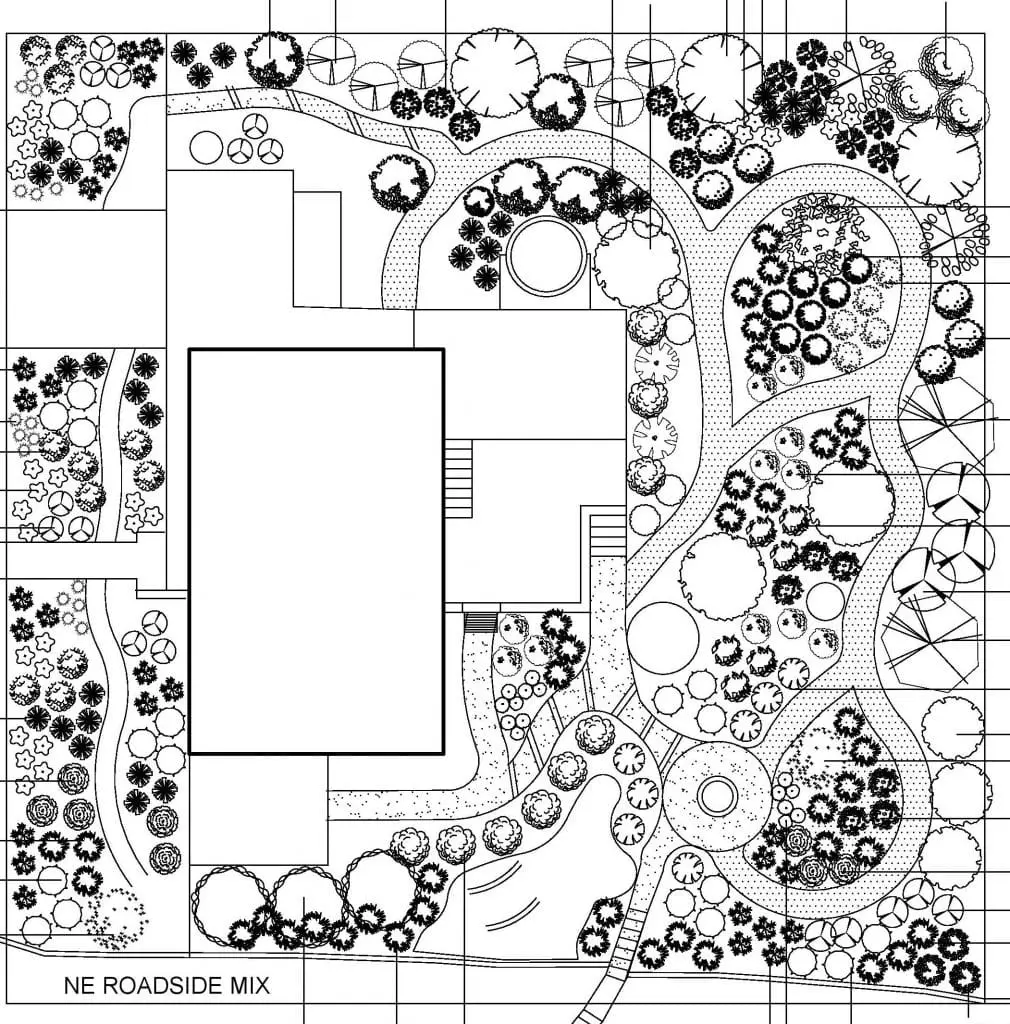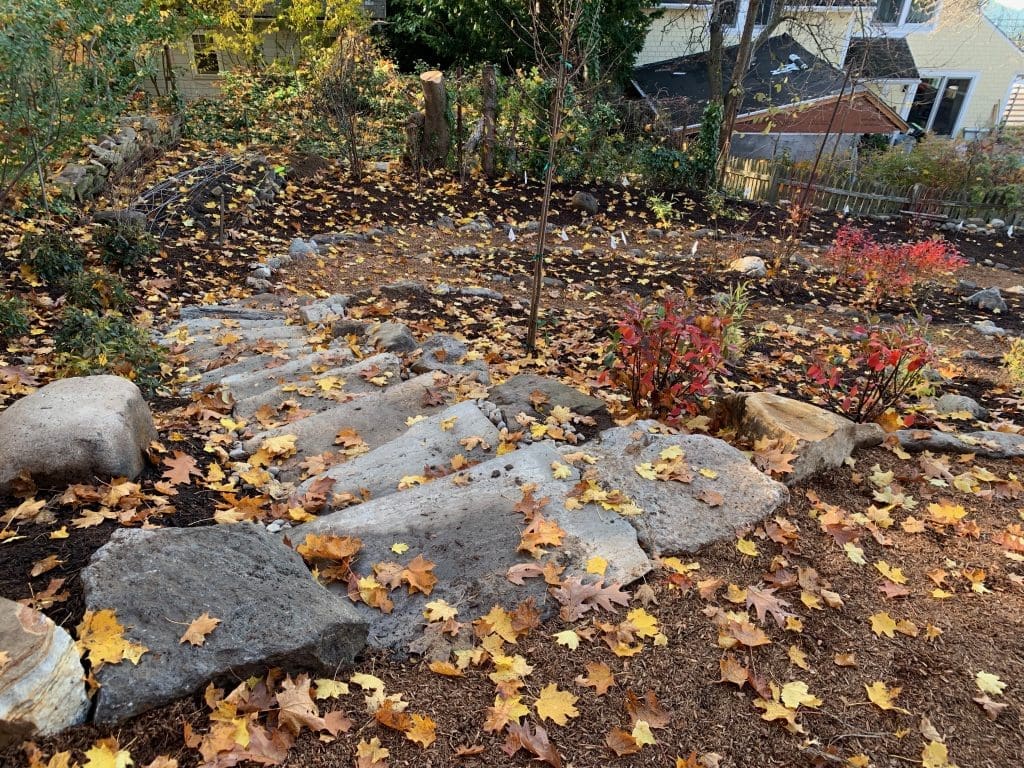Your permaculture terrace garden landscape will serve as an invitation to life…for all living beings great and small…plant, animal and mineral. The natural beauty and mystery of life, manifest in its many glorious forms and permutations, will inhabit your biosphere.
From the primal source of rich organic and mineral matter complete with fungi and bacteria as well as all the possibilities and resources for life, we will create the optimum habitat to nourish the nature of your living green, flowering and fruiting plants throughout the seasons of your life.
Jay Archer’s design concepts (above) start with big and bold goals: creating the conditions and habitat for life—in all its forms—to exist and THRIVE!

Permaculture Theory
Such a perspective aligns with the overall theory and framework of permaculture: that every living thing, no matter how small, plays a role in the health and functioning of our ecosystem. We are all interconnected and dependent upon a healthy and thriving ecosystem, and permaculture prescribes a holistic view of designing and creating with nature in a way that respects every plant, animal and microbe. As Jay says, first, we do no harm.
This framework permeated every aspect of the landscape design and installation. We used only natural-source products — yes they are organic, and toxin free, but equally important, they are either recyclable or can be repurposed in years to come. None of the materials we brought onto the landscape will end up in a landfill.
The landscape installation itself was entirely “quiet” — no power tools were used whatsoever! Given what we now know about high decibel sounds effect on our blood pressure and mental health, we always prefer to do quiet landscaping whenever possible!
Applying Permaculture to Landscape Design
Permaculture theory is often applied toward making more productive landscapes– both ecologically and as a means of nourishing ourselves. Permaculture foodscapes often implement edible perennials, fruiting trees and shrubs, and perennial culinary and medicinal herbs.
Successful food gardens require healthy populations of pollinators and beneficial insects, thus, permaculture also strives to create habitat for pollinators.
Human and animal foodscapes were certainly design goals for this Hasting-on-Hudson, NY property:
The energized exchange and interaction between diverse species populations will continually produce beautiful food, organically grown.

This landscape features* edibles including: Blueberry (native!), Redcurrant, Blackcurrant, Plum, Pawpaws (native!), Peaches and Goumi.


Medicinal and culinary herbs planted include: thyme, mint and natives Echinacea, yarrow, and goldenrod.

*Note: fruit trees are dug up in the spring and are thus only available at nurseries then; they will be planted in Spring 2021.
Why Perennial Edibles are Superior to Annuals
Permaculture is not a native-only design perspective. Many of these edibles are non-native, however they still attract many pollinators. By incorporating edible perennials, trees and shrubs, instead of relying solely on annuals, we are taking advantage of other plant characteristics as well.
For example, perennials have a deeper root system than annuals, better stabilizing the soil and preventing against erosion. As the root systems develop over the years, they improve soil structure by creating pathways for water, air and nutrients; these pathways also reduce soil compaction.

Photo by: Carbon Cycle Institute.
Perennials are able to uptake nutrients from deeper in the soil strata than annuals are, thereby providing greater nutrient cycling for all the plants and soil microbes in the microclimate.

Of course if we only ate perennial edibles we would deprive ourselves of many tasty and nutritious fruits and vegetables. This project also included a more traditional organic vegetable garden of annuals. However, the permaculture theory of making every landscape productive, enriching the soil and designing to nourish both humans and wildlife alike, permeated every aspect of this design.
Designing Organic Habitats
The peaceful harmony and coexistence of beneficial species in great biological diversity provide the highest value in ecosystem services. Day to day, the song of the birds, music of the bees and insects produce a symphony composed by nature, forever free of sour notes and pests unknown to true indigenous environments.
Promoting biodiversity and designing habitats for the permaculture landscape necessitates that the landscape be entirely toxin-free. All of GJL’s landscapes are maintained using NOFA Organic Land Care principals. We simply cannot plant plants to attract critical pollinators, only to have them poisoned upon pollination! Organic is the only way!

This permaculture landscape is a welcoming habitat for our critical pollinators and beneficial insects that not only pollinate many of our essential food crops and ornamental plants, but are also the foundation of the food chain for birds and other wildlife. Without insects our landscapes would suffer immeasurable harm – they are worth protecting!
Permaculture Design as an Environmental Solution
Living in the era of the Anthropocene, this living machine (your permaculture landscape) will act as an antidote to the myriad of negative human impacts actively affecting our health, the health of our environment and ultimately the health of this place we inhabit…our Earth…our Mother.
Another element of Permaculture design theory is designing with “stacked functions.” That means choosing and designing with plants to achieve multiple ecological services within one landscape.

For example, Northern Sea Oats is a native ornamental grass we planted. Its seed heads provide late-season food for birds, it is a host plant for number of moths, skippers and butterfly larvae, and its leaves are a great nesting material for birds as well. It is deep-rooted and its natural habitat is along stream banks, making it a great choice for erosion control projects such as this one.

Deep-rooted grasses are also fabulous at sequestering carbon and storing it in the soil (while woody plants like trees store carbon in their biomass). This landscape, with its diversity of deep-rooted grasses, trees, shrubs and perennials (and no lawn!) is on-track to becoming a carbon net-positive landscape!

With a smartly designed permaculture landscape, we can solve many of our present day environmental problems: ballooning GHG emissions, polluted air and water, eroded and deficient soil, food deserts, declining pollinator and wildlife habitat… every permaculture landscape can be part of the solution!

Designing for Erosion Control and Soil Conservation
This site is a steep slope in Hastings-on-Hudson, New York, a town within Westchester County. Existing vegetation included many invasive ‘weeds’ that were removed by hand. Jay designed a series of terraced gardens and walkways, manipulating and reinforcing the new grades to capture stormwater and prevent erosion.

Gently cascading topography with gentle paths and terraces will support and sustain your individual, unique plant communities.

Erosion control devices included placing cedar bark logs diagonally across the walkways, and backfilling with mulch to help slow down and allow water to infiltrate. The terraces were formed with twenty yards of boulders and rip rap (smaller sized stones) and filtrex socks. Plants were installed through Jute biodegradable natural coconut fiber netting.



The pathways were finished with certified playground mulch to contrast with the dark hardwood mulch on the garden beds. The pathways are lined with small fist-sized stones.

The result is a naturalistic, productive and thriving permaculture garden that can withstand our ever-more frequent storm events, allowing for soil and water conservation.
May you breathe deeply the fresh, clean air, the sweet fragrance of Providence as nature intended.
For the good of your children and your children’s children.
May you live in serene peace and happiness, now and always!
Jay Archer
Landscape Ecologist, Designer
Green Jay Landscape Design
914-560-6570